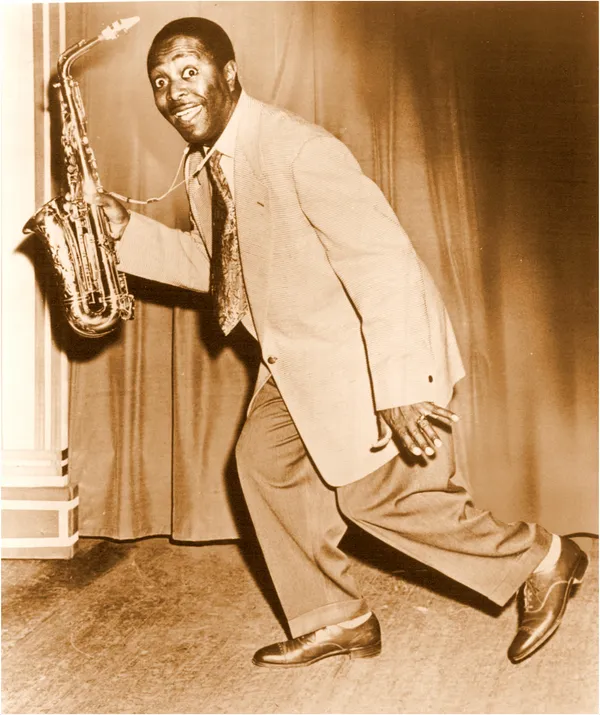Overview
Louis Jordan (1908–1975) was an American saxophonist, singer, songwriter, and bandleader, widely regarded as one of the most influential figures in 20th-century American music. Known as the “King of the Jukebox,” Jordan rose to prominence in the 1930s and 1940s, blending jazz, blues, boogie-woogie, and early rock influences into a style known as jump blues. His band, Louis Jordan and His Tympany Five, revolutionized popular music with hit songs such as Caldonia, Choo Choo Ch’Boogie, and Let the Good Times Roll (Giddins, 1998).
His energetic performances, witty lyrics, and danceable rhythms made him one of the most commercially successful Black artists of his time, dominating the R&B charts for nearly two decades.
Importance in Music History
- Pioneer of Jump Blues & R&B
Jordan’s music served as a crucial bridge between swing-era jazz and the emerging R&B and rock and roll genres (Shaw, 1986). His jump blues style, characterized by fast-paced rhythms and strong backbeats, directly influenced later R&B artists. - Influence on Rock and Roll
Jordan’s sound and stage charisma heavily influenced early rock pioneers such as Chuck Berry, Little Richard, and Bill Haley (Santoro, 1994). Berry once cited Jordan’s music as a direct influence on his guitar-driven style (Guralnick, 1995). - Chart Dominance & Crossover Appeal
Jordan was a dominant force on the R&B charts, scoring 18 No. 1 hits on Billboard’s R&B charts between 1942 and 1951 (Whitburn, 2004). His ability to cross over into mainstream audiences made him one of the first Black artists to achieve widespread popularity among both Black and white listeners. - Innovator in Music Performance & Film
Jordan utilized short musical films, or soundies, to promote his music visually. These early music videos showcased his dynamic stage presence and contributed to the evolution of televised music performances (Horne, 2001). - Lyrical and Thematic Impact
Jordan’s humorous, satirical, and storytelling lyrics set a new standard for songwriting in blues, R&B, and pop music. His song Saturday Night Fish Fry (1949) is considered one of the earliest examples of rock and roll lyrics (Wald, 2009). - Recognition and Legacy
Jordan’s influence has been recognized with multiple honors:- Rock and Roll Hall of Fame Induction (1987) (Rock & Roll Hall of Fame, 2023)
- Blues Hall of Fame Induction (1980)
- Grammy Lifetime Achievement Award (2018)
His music continues to inspire modern artists and remains a cornerstone of American popular music.
Conclusion
Louis Jordan was a transformative figure in American music, blending jazz, blues, and swing into a fresh, high-energy sound that laid the groundwork for R&B and rock and roll. His legacy endures through the rhythms, lyrics, and stage presence of countless artists, cementing his status as one of the most important musicians of the 20th century.
YouTube Topic Channel:
https://www.youtube.com/channel/UCwVR9kyiKn0NImzcT9Eq2NQ
References
- Giddins, G. (1998). Visions of Jazz: The First Century. Oxford University Press.
- Guralnick, P. (1995). Lost Highway: Journeys and Arrivals of American Musicians. Harper & Row.
- Horne, G. (2001). Race, Music, and the Formation of African American Culture. Palgrave Macmillan.
- Rock & Roll Hall of Fame. (2023). Inductees: Louis Jordan. Retrieved from www.rockhall.com
- Santoro, G. (1994). Highway 61 Revisited: The Tangled Roots of American Music. Oxford University Press.
- Shaw, A. (1986). Honkers and Shouters: The Golden Years of Rhythm and Blues. Macmillan.
- Wald, E. (2009). How the Beatles Destroyed Rock ’n’ Roll: An Alternative History of American Popular Music. Oxford University Press.
- Whitburn, J. (2004). Top R&B Singles: 1942–2004. Record Research.
Let me know if you need any modifications or additional details!


Leave a Reply